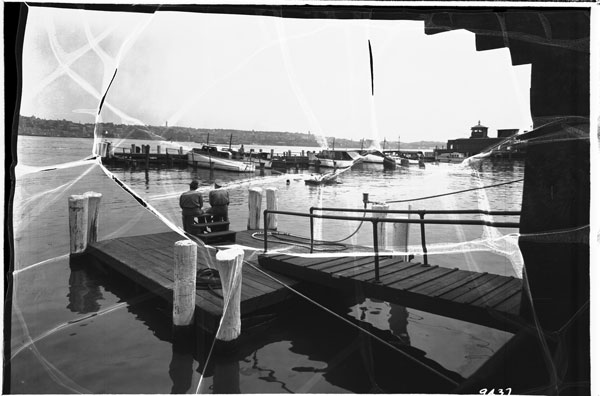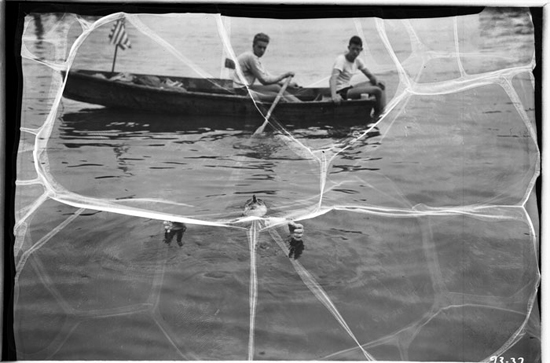“Somewhere between Here and Kingston”
A “Cliff Notes” Story
September 2002
As we catalogued photographic negatives this summer, a certain caption caught our eyes: Zimmerman - legless swimmer - Albany-New York. It was penciled on two envelopes, both holding negatives that, unfortunately, are fairly damaged, though still readable. One shows Alpine Boat Basin from by the gas dock. A couple of men are sitting on the dock watching a rowboat, which is alongside a man swimming in the middle of the basin. The other is a close-up of the swimmer. It is difficult to tell whether he has legs or not. He’s lying on his back, with what looks like a cigar poking up out of his mouth. (Of course, we figured, it must be some kind of breathing tube — you don’t swim 150 miles while you’re puffing on a cigar. Right?)


Beginning with a search of the New York Times Index for 1937, we were able to fill out the story of those photos a bit. The swimmer’s correct name was Charles Zibelman, though he went by Charles Zimmy. (We found him remembered on at least one web site as “Zimmy the Human Fish.”)
He lost his legs beneath the wheels of a trolley at the age of nine. He was 46 in 1937, residing in New York, but with a wife and two children in Florida. He made his livelihood through “swimming exhibitions.” He was able to stay in the water — even to sleep there — because the loss of his legs gave him almost supernatural buoyancy, like a cork.
During the last week of August in 1937, the Times followed his progress down the Hudson.
Tuesday, August 24. A day after diving off a pier in Albany, Zimmy made it to Coxsackie, NY.
For several hours this afternoon Zimmy lazed in the water off Old Rattlesnake Island, a mile and a half above here, smoked cigars and joked with occupants of passing boats while he waited for the tide to turn.
Around 7 PM, “using a strong overhand stroke,” Zimmy “disappeared downstream in the dusk.”
Wednesday, August 25. Zimmy made it to Saugerties — twice. After passing the village in the morning, the incoming tide pushed him back six miles. He came by again after 9:00 in the evening.
He was later reported as having reached Kingston, five miles downstream, but no verification was forthcoming from watchers along the route.
“He’s somewhere between here and Kingston,” said one.
Thursday, August 26. At 8:21 in the evening, Zimmy passed under the Mid-Hudson Bridge — the half-way point of his trip.
Through a reporter sent out in a motor launch to interview him, he sent this message to President Roosevelt at Hyde Park:
“I salute you from the waters of the Hudson.”…
Zimmy ended his 102nd hour in the water at midnight. … The Hudson was choppy, but the swimmer was making good progress.
Saturday, August 28. Zimmy made it to Rockland Landing in the evening, about 30 miles from New York. His plan remained to stay in the water for the duration of his journey.
Although Zimmy was sore all over — constant contact with the water has chafed his skin severely, it was reported — he refused to give up and announced as he floated around in the sheltered cove that he expected to reach the George Washington Bridge tomorrow.
… At 4 P.M. … he had been in the water 118 hours, having beaten his own record of swimming for 100 hours in a Honolulu pool in 1931, and also that of Otto Kemmerich …
(Acting on a wager nine years earlier, Otto Kemmerich had “dived into a Berlin pool with a sea lion and swam around until the animal collapsed after forty-two hours…”)
While at Rockland Landing, Zimmy put a fresh coat of grease on himself.
He had had the tide against him most of the day and he needed half a dozen sandwiches and a couple of cigars badly. Crowds cheered him from the shore and some dived in to join him in the water.
Sunday, August 29.
“Pooh! A sea lion,” [Zimmy’s] manager, Marvin Welt, said … “A sea lion is nothing. A fish, yes, but Zimmy might even outswim a fish.”
Zimmy passed Alpine Boat Basin at 11 in the morning, but then the tide pushed him back, and he ended up spending the afternoon within the marina. “His face was deeply tanned beneath a six days’ growth of beard,” and barnacles had attached themselves to him.
Several thousand men and women gathered along the shore. … He chatted freely with many of them between naps, in which he lay on the water with his hands crossed on his chest.
At about 1 o’clock the crew of the boat accompanying him fed him a steak sandwich in chunks, as he churned both hands in the water to hold himself in an upright position. He showed an unusual agility in the water, moving his massive arms with the power and the ease of a seal.
… Waving an after-dinner cigar in an expressive gesture, he said he had longed for sunshine during the days to counteract the chills from staying in the water overnight …
“When I finish this,” he told spectators, “my next big swim will be from Key West to Havana.”
He made it to his planned destination — the 125th Street Ferry dock, opposite Edgewater — around ten at night, but a strong tide swept him another mile or so down the river. A rowboat towed him back, “where an ambulance was waiting to take him to Harlem Hospital for rest and recuperation.”
He insisted on executing several dives before leaving the water to prove to several hundred spectators that he still was in good health after his long ordeal.
“I feel kind of funny being out of water,” he said.
Monday, August 30
Despite advice from physicians, who were concerned over his temperature of 100 degrees, Charles Zimmy … left Harlem Hospital …
Zimmy read with interest an … interview with Mrs. Lottie Moore Schoemmel, another marathon swimmer… She doubted that Zimmy could swim from Key West to Havana … on account of barracuda and other fish… Zimmy commented, “I’ve got a grease I use that I think will keep those fish away.”
– Eric Nelsen –

